A Review on Ecological and Environmental Impacts of Pumped Hydro Storage Based on CiteSpace Analysis
Abstract
1. Pumped Hydro Storage and Energy Challenges
1.1. Pumped Hydro Storage Technology and Its Development
1.2. Overview of Pumped Hydro Storage in Energy and Environmental Research
1.2.1. Functional Role of PHS from an Energy System Synergy Perspective
1.2.2. Dual Ecological–Environmental Effects
1.2.3. Synergistic Evolution of Policy and Technology
1.2.4. Current Research Gaps and This Study’s Contributions
2. Research Tools and Selection
2.1. Comparative Analysis of Classic Literature Research Tools
2.2. Core Advantages and Selection Rationale of CiteSpace
2.3. Operational Workflow of CiteSpace
2.4. Data Sources
3. Results
3.1. Analysis of Publication Trends
3.2. Regional and Institutional Analysis
3.2.1. Country/Region Analysis
3.2.2. Institutional Analysis
3.3. Research Hotspot Analysis
3.3.1. High-Frequency Keywords
3.3.2. Keyword Clustering
3.3.3. Keyword Burst Detection
3.3.4. Temporal Evolution of Keywords
4. Conclusions and Recommendations
4.1. Research Conclusions
4.2. Development Recommendations
Author Contributions
Funding
Data Availability Statement
Conflicts of Interest
References
- Ding, K.; Yang, C.H.; Wang, Z.X.; Zhao, C.J. Optimal scheduling of combined pumped storage-wind-photovoltaic-thermal generation system considering the characteristics of source and load. J. Renew. Sustain. Energy 2023, 15, 054701. [Google Scholar] [CrossRef]
- Kadiyala, A.; Kommalapati, R.; Huque, Z. Evaluation of the life cycle greenhouse gas emissions from different biomass feedstock electricity generation systems. Sustainability 2016, 8, 1181. [Google Scholar] [CrossRef]
- IRENA. Electricity Storage and Renewables: Costs and Markets to 2030; International Renewable Energy Agency: Abu Dhabi, United Arab Emirates, 2017; p. 103. ISBN 978-92-9260-038-9. [Google Scholar]
- Jurasz, J.; Dabek, P.B.; Kazmierczak, B.; Kies, A.; Wdowikowski, M. Large scale complementary solar and wind energy sources coupled with pumped-storage hydroelectricity for Lower Silesia (Poland). Energy 2018, 161, 183–192. [Google Scholar] [CrossRef]
- Zhou, J.L.; Liu, D.D.; Sha, R.; Sun, J.B.; Wang, Y.B.; Wu, Y.N. Geospatial simulation and decision optimization towards identifying the layout suitability and priority for wind-photovoltaic-hydrogen-ammonia project: An empirical study in China. Energy 2024, 286, 129489. [Google Scholar] [CrossRef]
- Suo, C.; Li, Y.P.; Jin, S.W.; Liu, J.; Li, Y.F.; Feng, R.F. Identifying optimal clean-production pattern for energy systems under uncertainty through introducing carbon emission trading and green certificate schemes. J. Clean. Prod. 2017, 161, 299–316. [Google Scholar] [CrossRef]
- Chala, G.T.; Al Alshaikh, S.M. Solar photovoltaic energy as a promising enhanced share of clean energy sources in the future—A comprehensive review. Energies 2023, 16, 7919. [Google Scholar] [CrossRef]
- Aly, A.M.; Clarke, J. Wind design of solar panels for resilient and green communities: CFD with machine learning. Sustain. Cities Soc. 2023, 94, 104529. [Google Scholar] [CrossRef]
- Li, R.; Afzali, S.F.; Mahalec, V. Environmental impacts of optimal designs of community energy systems under different CO2 footprints of electric grids. Comput. Chem. Eng. 2023, 178, 108389. [Google Scholar] [CrossRef]
- Zhang, H.Y.; Chen, B.; Deng, H.; Du, H.Y.; Yang, R.X.; Ju, L.; Liu, S.M. Analysis on the evolution law and influencing factors of Beijing’s power generation carbon emissions. Energy Rep. 2022, 8, 1689–1697. [Google Scholar] [CrossRef]
- Zhang, X.P.; Zhang, H.N.; Zhao, C.H.; Yuan, J.H. Carbon emission intensity of electricity generation in Belt and Road Initiative countries: A benchmarking analysis. Environ. Sci. Pollut. Res. 2019, 26, 15057–15068. [Google Scholar] [CrossRef] [PubMed]
- Nian, V.; Chou, S.K.; Su, B.; Bauly, J. Life cycle analysis on carbon emissions from power generation–The nuclear energy example. Appl. Energy 2014, 118, 68–82. [Google Scholar] [CrossRef]
- Zhao, E.R.; Chen, J.M.; Lan, J.M.; Liu, L.W. Power Generation Mix Optimization under Auction Mechanism for Carbon Emission Rights. Energies 2024, 17, 617. [Google Scholar] [CrossRef]
- Li, D.; Shen, L.; Zhong, S.; Elshkaki, A.; Li, X.M. Spatial and temporal evolution patterns of material, energy and carbon emission nexus for power generation infrastructure in China. Resour. Conserv. Recycl. 2023, 190, 106775. [Google Scholar] [CrossRef]
- Zhang, X.; Xu, K. Statistical data-based prediction of carbon dioxide emission factors of China’s power generation at carbon peak in 2030. Case Stud. Therm. Eng. 2023, 51, 103633. [Google Scholar] [CrossRef]
- Wang, Y.; Yao, X.; Yuan, P. Strategic adjustment of China’s power generation capacity structure under the constraint of carbon emission. Comput. Econ. 2015, 46, 421–435. [Google Scholar] [CrossRef]
- Huang, K.; Zhou, P.; Liu, Z.Y.; Tang, T.L.; Zhang, H.G.; Jiang, W. The calculation and distribution of CAV carbon emissions on urban transportation systems: A comparative analysis of renewable and non-renewable energy sources. Renew. Energy 2024, 230, 120884. [Google Scholar] [CrossRef]
- Deka, A.; Ozdeser, H.; Seraj, M. The effect of GDP, renewable energy and total energy supply on carbon emissions in the EU-27: New evidence from panel GMM. Environ. Sci. Pollut. Res. 2023, 30, 28206–28216. [Google Scholar] [CrossRef] [PubMed]
- Shang, M.; Peng, M.Y.P.; Anser, M.K.; Imran, M.; Nassani, A.A.; Binsaeed, R.H.; Zaman, K. Evaluating the U-shaped environmental kuznets curve in China: The impact of high technology exports and renewable energy consumption on carbon emissions. Gondwana Res. 2024, 127, 272–287. [Google Scholar] [CrossRef]
- Erdogan, E.; Serin Oktay, D.; Manga, M.; Bal, H.; Algan, N. Examining the effects of renewable energy and economic growth on carbon emission in Canada: Evidence from the Nonlinear ARDL Approaches. Eval. Rev. 2024, 48, 63–89. [Google Scholar] [CrossRef] [PubMed]
- Liu, X.X.; Niu, Q.; Dong, S.L.; Zhong, S.Y. How does renewable energy consumption affect carbon emission intensity? Temporal-spatial impact analysis in China. Energy 2023, 284, 128690. [Google Scholar] [CrossRef]
- Deka, A.; Bako, S.Y.; Ozdeser, H.; Seraj, M. The impact of energy efficiency in reducing environmental degradation: Does renewable energy and forest resources matter? Environ. Sci. Pollut. Res. 2023, 30, 86957–86972. [Google Scholar] [CrossRef]
- Li, C.; Yang, X.; Wang, L. The Impact of Renewable Energy Development on Regional Carbon Emission Reduction: Based on the Spatio-Temporal Analysis of 30 Provinces in China. Environ. Manag. 2024, 74, 439–460. [Google Scholar] [CrossRef]
- Zhang, M.M.; Yang, Z.K.; Liu, L.Y.; Zhou, D.Q. Impact of renewable energy investment on carbon emissions in China-An empirical study using a nonparametric additive regression model. Sci. Total Environ. 2021, 785, 147109. [Google Scholar] [CrossRef] [PubMed]
- Yin, G.Z.; Wang, B.X.; Duan, M.S.; Kuang, Y. Integrating more renewable electricity into the power system may increase carbon emissions. Sustain. Energy Technol. Assess. 2022, 49, 101796. [Google Scholar] [CrossRef]
- Khan, H.; Liu, W.L.; Khan, I.; Zhang, J.F. The nexus between natural resources, renewable energy consumption, economic growth, and carbon dioxide emission in BRI countries. Environ. Sci. Pollut. Res. 2023, 30, 36692–36709. [Google Scholar] [CrossRef]
- Guo, X.X.; Huang, K.X.; Li, L.Y.; Wang, X.A. Renewable energy for balancing carbon emissions and reducing carbon transfer under global value chains: A way forward. Sustainability 2022, 15, 234. [Google Scholar] [CrossRef]
- Martínez-Lucas, G.; Sarasúa, J.I.; Sánchez-Fernández, J.Á. Frequency regulation of a hybrid wind–hydro power plant in an isolated power system. Energies 2018, 11, 239. [Google Scholar] [CrossRef]
- Virasjoki, V.; Rocha, P.; Siddiqui, A.S.; Salo, A. Market impacts of energy storage in a transmission-constrained power system. IEEE Trans. Power Syst. 2015, 31, 4108–4117. [Google Scholar] [CrossRef]
- De Boer, H.S.; Grond, L.; Moll, H.; Benders, R. The application of power-to-gas, pumped hydro storage and compressed air energy storage in an electricity system at different wind power penetration levels. Energy 2014, 72, 360–370. [Google Scholar] [CrossRef]
- Hunt, J.D.; Lagore, B.; Brandao, R.; Diuana, F.A.; Quaranta, E.; de Miranda, M.; Lacorte, A.; Barbosa, P.S.; Aurelio, M.; de Freitas, V.; et al. Mapping the potential for pumped storage using existing lower reservoirs. J. Energy Storage 2023, 73, 109047. [Google Scholar] [CrossRef]
- Garcia, R.; Freire, F.; Clift, R. Effects on greenhouse gas emissions of introducing electric vehicles into an electricity system with large storage capacity. J. Ind. Ecol. 2018, 22, 288–299. [Google Scholar] [CrossRef]
- Das, B.K.; Hasan, M.; Das, P. Impact of storage technologies, temporal resolution, and PV tracking on stand-alone hybrid renewable energy for an Australian remote area application. Renew. Energy 2021, 173, 362–380. [Google Scholar] [CrossRef]
- Li, P.; Hu, D.; Hou, L.; Wang, J.H.; Pan, Y.P. Comprehensive Benefits Evaluation of Renewable Energy Based on Grey-DEMATEL and DQ-GRA. IEEE Access 2024, 12, 98660–98671. [Google Scholar] [CrossRef]
- Park, E.; Han, T.; Kim, T.; Kwon, S.J.; del Pobil, A.P. Economic and environmental benefits of optimized hybrid renewable energy generation systems at Jeju National University, South Korea. Sustainability 2016, 8, 877. [Google Scholar] [CrossRef]
- Zhang, S.S.; Yang, W.J.; Li, X.D.; Zhao, Z.G.; Wang, R.; Li, Y.L. Economic evaluation of Wind–PV–Pumped storage hybrid system considering carbon emissions. Energy Rep. 2022, 8, 1249–1258. [Google Scholar] [CrossRef]
- Açıkel, H.H.; Bayır, E. Evaluation of capacity of hybrid energy systems to decrease the environmental pollution. Fuel 2022, 328, 125356. [Google Scholar] [CrossRef]
- Zhao, H.; Guo, S. External benefit evaluation of renewable energy power in China for sustainability. Sustainability 2015, 7, 4783–4805. [Google Scholar] [CrossRef]
- Alhijazi, A.A.K.; Almasri, R.A.; Alloush, A.F. A Hybrid Renewable Energy (Solar/Wind/Biomass) and Multi-Use System Principles, Types, and Applications: A Review. Sustainability 2023, 15, 16803. [Google Scholar] [CrossRef]
- Vergara-Zambrano, J.; Kracht, W.; Díaz-Alvarado, F.A. Integration of renewable energy into the copper mining industry: A multi-objective approach. J. Clean. Prod. 2022, 372, 133419. [Google Scholar] [CrossRef]
- Nurunnabi, M.; Roy, N.K.; Mahmud, M.A. Investigating the environmental and socio-economic impacts of grid-tied photovoltaic and on-shore wind systems in Bangladesh. IET Renew. Power Gener. 2018, 12, 1082–1090. [Google Scholar] [CrossRef]
- Shahzad, M.; Qadir, A.; Ullah, N.; Mahmood, Z.; Saad, N.M.; Ali, S.S.A. Optimization of on-grid hybrid renewable energy system: A case study on Azad Jammu and Kashmir. Sustainability 2022, 14, 5757. [Google Scholar] [CrossRef]
- Zhang, J.; Wei, H. A review on configuration optimization of hybrid energy system based on renewable energy. Front. Energy Res. 2022, 10, 977925. [Google Scholar] [CrossRef]
- Purvins, A.; Zubaryeva, A.; Llorente, M.; Tzimas, E.; Mercier, A. Challenges and options for a large wind power uptake by the European electricity system. Appl. Energy 2011, 88, 1461–1469. [Google Scholar] [CrossRef]
- Dursun, B.; Alboyaci, B. The contribution of wind-hydro pumped storage systems in meeting Turkey’s electric energy demand. Renew. Sustain. Energy Rev. 2010, 14, 1979–1988. [Google Scholar] [CrossRef]
- Argyrou, M.C.; Christodoulides, P.; Kalogirou, S.A. Energy storage for electricity generation and related processes: Technologies appraisal and grid scale applications. Renew. Sustain. Energy Rev. 2018, 94, 804–821. [Google Scholar] [CrossRef]
- Suberu, M.Y.; Mustafa, M.W.; Bashir, N. Energy storage systems for renewable energy power sector integration and mitigation of intermittency. Renew. Sustain. Energy Rev. 2014, 35, 499–514. [Google Scholar] [CrossRef]
- Joshua, S.R.; Park, S.; Kwon, K. H2 URESONIC: Design of a Solar-Hydrogen University Renewable Energy System for a New and Innovative Campus. Appl. Sci. 2024, 14, 1554. [Google Scholar] [CrossRef]
- Uyar, T.S.; Beşikci, D. Integration of hydrogen energy systems into renewable energy systems for better design of 100% renewable energy communities. Int. J. Hydrogen Energy 2017, 42, 2453–2456. [Google Scholar] [CrossRef]
- Grosspietsch, D.; Saenger, M.; Girod, B. Matching decentralized energy production and local consumption: A review of renewable energy systems with conversion and storage technologies. Wiley Interdiscip. Rev. Energy Environ. 2019, 8, e336. [Google Scholar] [CrossRef]
- Herc, L.; Pfeifer, A.; Duić, N. Optimization of the possible pathways for gradual energy system decarbonization. Renew. Energy 2022, 193, 617–633. [Google Scholar] [CrossRef]
- Shahzad, S.; Jasińska, E. Renewable revolution: A review of strategic flexibility in future power systems. Sustainability 2024, 16, 5454. [Google Scholar] [CrossRef]
- Shahzad, S.; Abbasi, M.A.; Shahid, M.B.; Guerrero, J.M. Unlocking the potential of long-duration energy storage: Pathways to net-zero emissions through global innovation and collaboration. J. Energy Storage 2024, 97, 112904. [Google Scholar] [CrossRef]
- Palacios-Ferrer, J.A.; Rey-Martínez, F.J.; Repenning-Bzdigian, C.A.; Rey-Hernández, J.M. Unveiling Key Factors Shaping Energy Storage Strategies for Sustainable Energy Communities. Buildings 2024, 14, 1466. [Google Scholar] [CrossRef]
- Reuter, W.H.; Fuss, S.; Szolgayová, J.; Obersteiner, M. Investment in wind power and pumped storage in a real options model. Renew. Sustain. Energy Rev. 2012, 16, 2242–2248. [Google Scholar] [CrossRef]
- Bi, C.; Law, A.W.K. Co-locating offshore wind and floating solar farms–effect of high wind and wave conditions on solar power performance. Energy 2023, 266, 126437. [Google Scholar] [CrossRef]
- Etyemezian, V.; Nikolich, G.; Gillies, J.A. Mean flow through utility scale solar facilities and preliminary insights on dust impacts. J. Wind Eng. Ind. Aerodyn. 2017, 162, 45–56. [Google Scholar] [CrossRef]
- Wu, X.W.; Hu, W.H.; Huang, Q.; Chen, C.; Liu, Z.; Chen, Z. Optimal power dispatch strategy of onshore wind farms considering environmental impact. Int. J. Electr. Power Energy Syst. 2020, 116, 105548. [Google Scholar] [CrossRef]
- Soudagar, M.E.M.; Ramesh, S.; Khan, T.M.Y.; Almakayeel, N.; Ramesh, R.; Ghazali, N.N.N.; Cuce, E.; Shelare, S. An overview of the existing and future state of the art advancement of hybrid energy systems based on PV-solar and wind. Int. J. Low-Carbon Technol. 2024, 19, 207–216. [Google Scholar] [CrossRef]
- Yeo, I.A.; Yee, J.J. A proposal for a site location planning model of environmentally friendly urban energy supply plants using an environment and energy geographical information system (E-GIS) database (DB) and an artificial neural network (ANN). Appl. Energy 2014, 119, 99–117. [Google Scholar] [CrossRef]
- Wu, Z.; Zhou, Z.; Alkahtani, M. Time-effective dust deposition analysis of PV modules based on finite element simulation for candidate site determination. IEEE Access 2020, 8, 65137–65147. [Google Scholar] [CrossRef]
- Panda, A.; Aviso, K.B.; Mishra, U.; Nanda, I. Impact of optimal power generation scheduling for operating cleaner hybrid power systems with energy storage. Int. J. Energy Res. 2021, 45, 14493–14517. [Google Scholar] [CrossRef]
- Elnozahy, A.; Ramadan, H.S.; Abo-Elyousr, F.K. Efficient metaheuristic Utopia-based multi-objective solutions of optimal battery-mix storage for microgrids. J. Clean. Prod. 2021, 303, 127038. [Google Scholar] [CrossRef]
- Oliveira, L.; Messagie, M.; Mertens, J.; Laget, H.; Coosemans, T.; Van Mierlo, J. Environmental performance of electricity storage systems for grid applications, a life cycle approach. Energy Convers. Manag. 2015, 101, 326–335. [Google Scholar] [CrossRef]
- Jiao, Y.; Månsson, D. Greenhouse gas emissions from hybrid energy storage systems in future 100% renewable power systems–A Swedish case based on consequential life cycle assessment. J. Energy Storage 2023, 57, 106167. [Google Scholar] [CrossRef]
- Cheng, C.; Gutierrez, N.P.; Blakers, A.; Stocks, M. GIS-based solar and wind resource assessment and least-cost 100% renewable electricity modelling for Bolivia. Energy Sustain. Dev. 2022, 69, 134–149. [Google Scholar] [CrossRef]
- De Moura Altea, C.; Yanagihara, J.I. Energy, exergy and environmental impacts analyses of Pumped Hydro Storage (PHS) and Hydrogen (H2) energy storage processes. J. Energy Storage 2024, 76, 109713. [Google Scholar] [CrossRef]
- Rogeau, A.; Girard, R.; Kariniotakis, G. A generic GIS-based method for small Pumped Hydro Energy Storage (PHES) potential evaluation at large scale. Appl. Energy 2017, 197, 241–253. [Google Scholar] [CrossRef]
- Javed, M.S.; Ma, T.; Jurasz, J.; Mikulik, J. A hybrid method for scenario-based techno-economic-environmental analysis of off-grid renewable energy systems. Renew. Sustain. Energy Rev. 2021, 139, 110725. [Google Scholar] [CrossRef]
- Sanna, A.; Streicher, W. Innovative system for BWRO desalination powered by PV and pumped hydro storage–Economic and GHG emissions analysis. Desalination 2024, 570, 117081. [Google Scholar] [CrossRef]
- Katsaprakakis, D.A.; Dakanali, E.; Dimopoulos, A.; Gyllis, Y. Energy transition on sifnos: An approach to economic and social transition and development. Appl. Sci. 2022, 12, 2680. [Google Scholar] [CrossRef]
- Moreno-Leiva, S.; Haas, J.; Nowak, W.; Kracht, W.; Eltrop, L.; Breyer, C. Integration of seawater pumped storage and desalination in multi-energy systems planning: The case of copper as a key material for the energy transition. Appl. Energy 2021, 299, 117298. [Google Scholar] [CrossRef]
- Li, S.; Hu, Y.; Zhang, L. Coupling coordination relationship of pumped storage power station and eco-environment system. J. Energy Storage 2022, 52, 105029. [Google Scholar] [CrossRef]
- Casasso, A.; Sethi, R. Assessment and minimization of potential environmental impacts of ground source heat pump (GSHP) systems. Water 2019, 11, 1573. [Google Scholar] [CrossRef]
- Luna, T.; Ribau, J.; Figueiredo, D.; Alves, R. Improving energy efficiency in water supply systems with pump scheduling optimization. J. Clean. Prod. 2019, 213, 342–356. [Google Scholar] [CrossRef]
- Arena, C.; Genco, M.; Lombardo, A.; Meli, I.; Mazzola, M.R. A Cost–Benefit Based, Parametric Procedure to Screen Existing Irrigation and Municipal Supply Reservoirs for Wind Energy Storage. Water 2018, 10, 1813. [Google Scholar] [CrossRef]
- Guo, Z.; Ge, S.S.; Yao, X.L.; Li, H.; Li, X.Y. Life cycle sustainability assessment of pumped hydro energy storage. Int. J. Energy Res. 2020, 44, 192–204. [Google Scholar] [CrossRef]
- Zhang, S.; Andrews-Speed, P.; Perera, P. The evolving policy regime for pumped storage hydroelectricity in China: A key support for low-carbon energy. Appl. Energy 2015, 150, 15–24. [Google Scholar] [CrossRef]
- Nibbi, L.; Sospiro, P.; De Lucia, M.; Wu, C.C. Improving pumped hydro storage flexibility in China: Scenarios for advanced solutions adoption and policy recommendations. Energies 2022, 15, 7918. [Google Scholar] [CrossRef]
- Silalahi, D.F.; Blakers, A.; Cheng, C. 100% renewable electricity in Indonesia. Energies 2023, 17, 3. [Google Scholar] [CrossRef]
- Silalahi, D.F.; Blakers, A.; Lu, B.; Cheng, C. Indonesia’s Vast Off-River Pumped Hydro Energy Storage Potential. Energies 2022, 15, 3457. [Google Scholar] [CrossRef]
- Li, X.D.; Yang, W.J.; Zhao, Z.G.; Wang, R.; Yin, X.X. Advantage of priority regulation of pumped storage for carbon-emission-oriented co-scheduling of hybrid energy system. J. Energy Storage 2023, 58, 106400. [Google Scholar] [CrossRef]
- Hu, K.; Deng, Y.; Chen, D. Advantages of variable-speed pumped storage plants in generating phase-modulation mode: Rapidity and stability. IET Renew. Power Gener. 2020, 14, 3732–3740. [Google Scholar] [CrossRef]
- Deng, Y.W.; Wang, P.F.; Morabito, A.; Feng, W.F.; Mahmud, A.; Chen, D.Y.; Hendrick, P. Dynamic analysis of variable-speed pumped storage plants for mitigating effects of excess wind power generation. Int. J. Electr. Power Energy Syst. 2022, 135, 107453. [Google Scholar] [CrossRef]
- Wang, H.R.; Wang, L.Q.; Wang, X.B.; Yao, E.R. A novel pumped hydro combined with compressed air energy storage system. Energies 2013, 6, 1554–1567. [Google Scholar] [CrossRef]
- Yao, W.W.; Deng, C.H.; Li, D.L.; Chen, M.; Peng, P.; Zhang, H. Optimal sizing of seawater pumped storage plant with variable-speed units considering offshore wind power accommodation. Sustainability 2019, 11, 1939. [Google Scholar] [CrossRef]
- Li, S.; Cao, Z.Z.; Hu, K.Q.; Chen, D.Y. Performance assessment for primary frequency regulation of variable-speed pumped storage plant in isolated power systems. Energies 2023, 16, 1238. [Google Scholar] [CrossRef]
- Obara, S.; Morel, J.; Okada, M.; Kobayashi, K. Performance evaluation of an independent microgrid comprising an integrated coal gasification fuel cell combined cycle, large-scale photovoltaics, and a pumped-storage power station. Energy 2016, 116, 78–93. [Google Scholar] [CrossRef]
- Luo, Z.; Ma, J.; Jiang, Z. Research on power system dispatching operation under high proportion of wind power consumption. Energies 2022, 15, 6819. [Google Scholar] [CrossRef]
- Koutnik, J.; Bruns, M.; Hildinger, T. A Step forward—Variable Speed Pumped Storage Power Plant Frades II. Wasserwirtschaft 2015, 105, 27–32. [Google Scholar] [CrossRef]
- Azbe, V.; Mihalic, R. Transient stability of a large doubly-fed induction machine in a pumped-storage plant. Electr. Power Syst. Res. 2017, 142, 29–35. [Google Scholar] [CrossRef]
- Chen, Y.; Chen, C.M.; Liu, Z.Y.; Hu, Z.G.; Wang, X.W. Methodological features of CiteSpace Knowledge Graph. Sci. Res. 2015, 33, 242–253. [Google Scholar]
- Xiao, F.J.; Li, C.Z.; Sun, J.M.; Zhang, L.J. Knowledge domain and emerging trends in organic photovoltaic technology: A scientometric review based on CiteSpace analysis. Front. Chem. 2017, 5, 67. [Google Scholar] [CrossRef]
- Yang, W.; Yang, J. Advantage of variable-speed pumped storage plants for mitigating wind power variations: Integrated modelling and performance assessment. Appl. Energy 2019, 237, 720–732. [Google Scholar] [CrossRef]
- Guezgouz, M.; Jurasz, J.; Bekkouche, B.; Ma, T.; Javed, M.S.; Kies, A. Optimal hybrid pumped hydro-battery storage scheme for off-grid renewable energy systems. Energy Convers. Manag. 2019, 199, 112046. [Google Scholar] [CrossRef]
- Ghasemi, A.; Enayatzare, M. Optimal energy management of a renewable-based isolated microgrid with pumped-storage unit and demand response. Renew. Energy 2018, 123, 460–474. [Google Scholar] [CrossRef]
- Xu, X.; Hu, W.H.; Cao, D.; Huang, Q.; Chen, C.; Chen, Z. Optimized sizing of a standalone PV-wind-hydropower station with pumped-storage installation hybrid energy system. Renew. Energy 2020, 147, 1418–1431. [Google Scholar] [CrossRef]
- Sun, K.Q.; Li, K.J.; Pan, J.P.; Liu, Y.; Liu, Y.L. An optimal combined operation scheme for pumped storage and hybrid wind-photovoltaic complementary power generation system. Appl. Energy 2019, 242, 1155–1163. [Google Scholar] [CrossRef]
- Lyu, X.; Yang, K.; Fang, J.J.; Tang, J.Z.; Wang, Y. Feasibility study of construction of pumped storage power station using abandoned mines: A case study of the Shitai mine. Energies 2022, 16, 314. [Google Scholar] [CrossRef]
- Ge, S.; Gao, Y.; Yao, X.; Liu, J. Can pumped-storage power in underground coal mine reduce carbon emissions? J. Clean. Prod. 2020, 255, 120344. [Google Scholar] [CrossRef]
- Shang, D.; Pei, P. Analysis of influencing factors of modification potential of abandoned coal mine into pumped storage power station. J. Energy Resour. Technol. 2021, 143, 112003. [Google Scholar] [CrossRef]
- Zhang, T.; Zhang, B. Study on the hydraulic effect of Tesla valve structure on the end roadway of abandoned coal mine pumped storage. J. Energy Storage 2024, 95, 112586. [Google Scholar] [CrossRef]
- Shang, D.; Pei, P.; Zuo, Y. Techno-economic feasibility analysis of pumped storage hydroelectricity in abandoned underground coal mines. J. Energy Resour. Technol. 2020, 142, 122001. [Google Scholar] [CrossRef]
- Yang, K.; Lyu, X.; Xu, C.S.; Fang, J.J.; Duan, M.K.; Zhang, Z.N. Research on pumped storage and complementary energy development models for abandoned mines in China. J. Cent. South Univ. 2024, 31, 2860–2871. [Google Scholar] [CrossRef]
- Zhang, Y.; Xie, Z. Thermodynamic efficiency and bounds of pumped thermal electricity storage under whole process ecological optimization. Renew. Energy 2022, 188, 711–720. [Google Scholar] [CrossRef]
- National Energy Administration. Medium and Long-Term Development Plan for Pumped Hydro Storage (2021–2035); National Energy Administration: Beijing, China, 2021. [Google Scholar]
- US Department of Energy. HydroWIRES Initiative Research Roadmap; DOE: Washington, DC, USA, 2022.
- Chen, C. CiteSpace: A Practical Guide for Mapping Scientific Literature; Nova Science: Hauppauge, NY, USA, 2016. [Google Scholar]
- Yang, C.J.; Jackson, R.B. Opportunities and barriers to pumped-hydro energy storage in the United States. Renew. Sustain. Energy Rev. 2011, 15, 839–844. [Google Scholar] [CrossRef]
- Marín, O.A.; Kraslawski, A.; Cisternas, L.A. Design for sustainability: An integrated pumped hydro reverse osmosis system to supply water and energy for mining operations. Energy Convers. Manag. 2024, 322, 119159. [Google Scholar] [CrossRef]
- Li, J.L.; Zhao, Z.W.; Xu, D.; Li, P.Q.; Liu, Y.; Mahmud, M.A.; Chen, D.Y. The potential assessment of pump hydro energy storage to reduce renewable curtailment and CO2 emissions in Northwest China. Renew. Energy 2023, 212, 82–96. [Google Scholar] [CrossRef]
- Gemechu, E.; Kumar, A. A review of how life cycle assessment has been used to assess the environmental impacts of hydropower energy. Renew. Sustain. Energy Rev. 2022, 167, 112684. [Google Scholar] [CrossRef]
- Shi, Y.H.; Wang, H.L.; Li, C.J.; Negnevitsky, M.; Wang, X.L. Stochastic optimization of system configurations and operation of hybrid cascade hydro-wind-photovoltaic with battery for uncertain medium-and long-term load growth. Appl. Energy 2024, 364, 123127. [Google Scholar] [CrossRef]
- Ruiz, R.A.; Schürenkamp, D.; Bricker, J.D.; Olvermann, M.; Goseberg, N. Understanding stakeholder attitudes towards low-head pumped hydro storage technology. Energy Sustain. Soc. 2024, 14, 31. [Google Scholar] [CrossRef]
- He, F.; Leach, M.; Short, M.; Fan, Y.R.; Liu, L.R. A copula-based whole system model to understand the environmental and economic impacts of grid-scale energy storage. Appl. Energy 2025, 379, 124935. [Google Scholar] [CrossRef]
- Maio, M.; Marrasso, E.; Roselli, C.; Sasso, M.; Fontana, N.; Marini, G. An innovative approach for optimal selection of pumped hydro energy storage systems to foster sustainable energy integration. Renew. Energy 2024, 227, 120533. [Google Scholar] [CrossRef]
- Sadhukhan, J.; Sen, S.; Randriamahefasoa, T.M.S. Framework for optimal energy storage duration for maximum-reliability renewable electricity. Front. Energy Res. 2024, 12, 1430413. [Google Scholar] [CrossRef]
- Ba-abbad, M.A.; Alrougy, I.; Alalweet, F. Techno-economic analysis of implementing pumped hydro energy storage to store solar and wind energy in water-stressed areas. J. Energy Storage 2024, 98, 113024. [Google Scholar] [CrossRef]
- Maio, M.; Marrasso, E.; Roselli, C.; Sasso, M.; Fontana, N.; Marini, G. Spatial-temporal evolution of pumped hydro energy storage potential on the Qinghai–Tibet Plateau and its future trend under global warming. Sci. Total Environ. 2023, 857, 159332. [Google Scholar]
- Hasan, M.M.; Hossain, S.; Mofijur, M.; Kabir, Z.; Badruddin, I.A.; Khan, T.M.Y.; Jassim, E. Harnessing solar power: A review of photovoltaic innovations, solar thermal systems, and the dawn of energy storage solutions. Energies 2023, 16, 6456. [Google Scholar] [CrossRef]
- Kokkotis, P.I.; Psomopoulos, C.S.; Ioannidis, G.C.; Kaminaris, S.D. Small scale energy storage systems. A short review in their potential environmental impact. Fresenius Environ. Bull. 2017, 26, 5658–5665. [Google Scholar]
- Casarin, S.; Cavazzini, G.; Pérez-Díaz, J.I. Battery and Flywheel hybridization of a reversible Pumped-Storage Hydro Power Plant for wear and tear reduction. J. Energy Storage 2023, 71, 108059. [Google Scholar] [CrossRef]
- Rasool, M.H.; Taylan, O.; Perwez, U.; Batunlu, C. Comparative assessment of multi-objective optimization of hybrid energy storage system considering grid balancing. Renew. Energy 2023, 216, e119107. [Google Scholar] [CrossRef]
- Commission, E. The European Green Deal; COM(2019) 640 final; European Commission: Brussels, Belgium, 2019. [Google Scholar]
- US Department of Energy. Implementation Rules of the Bipartisan Infrastructure Act; US Department of Energy: Washington, DC, USA, 2021.
- National Development and Reform Commission, National Energy Administration. Implementation Plan for the Development of New Energy Storage during the 14th Five-Year Plan; National Development and Reform Commission, National Energy Administration: Washington, DC, USA, 2022.
- Weber, T.; Stocks, R.; Blakers, A.; Nadolny, A.; Cheng, C. A global atlas of pumped hydro systems that repurpose existing mining sites. Renew. Energy 2024, 224, 120113. [Google Scholar] [CrossRef]
- Zakeri, B.; Hunt, J.D.; Laldjebaev, M.; Krey, V.; Vinca, A.; Parkinson, S.; Riahi, K. Role of energy storage in energy and water security in Central Asia. J. Energy Storage 2022, 50, 104587. [Google Scholar] [CrossRef]
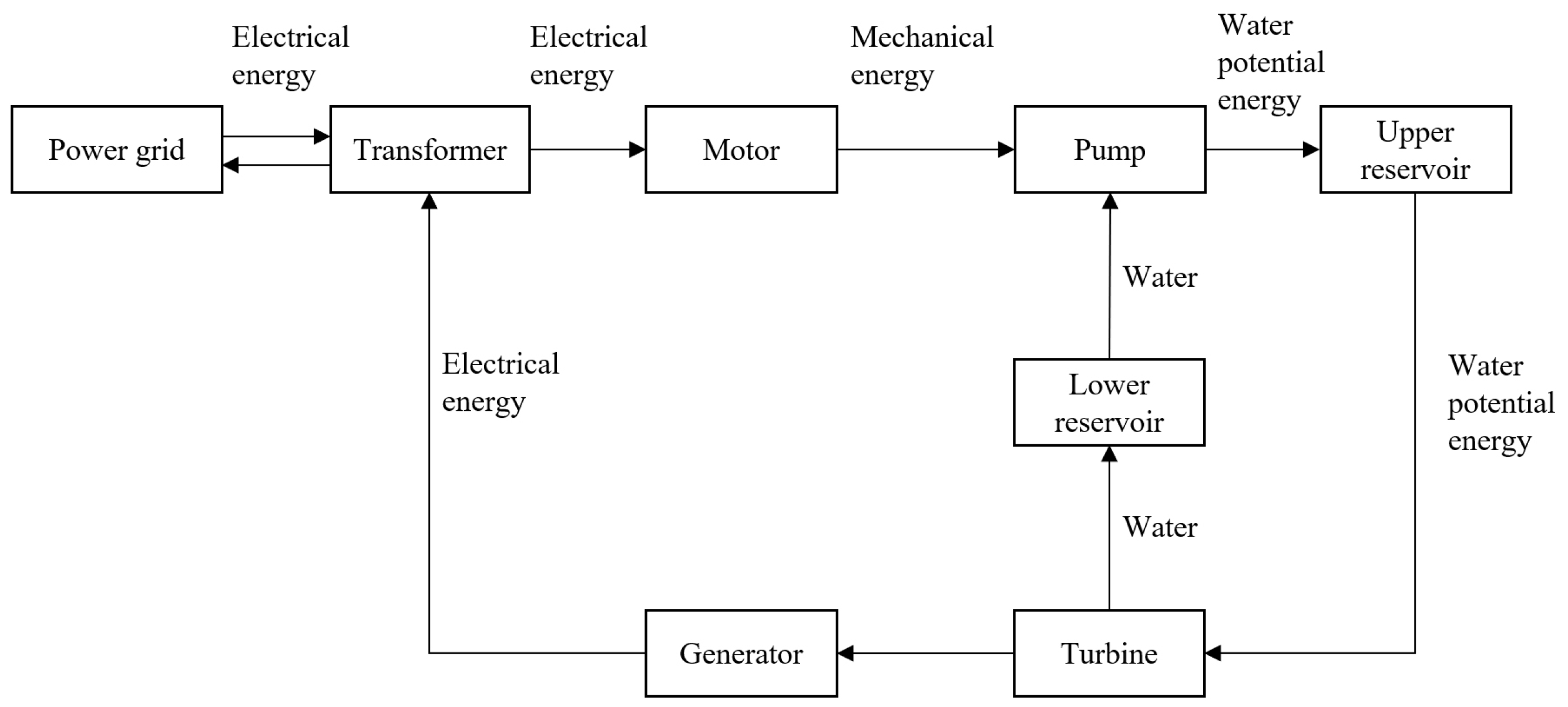
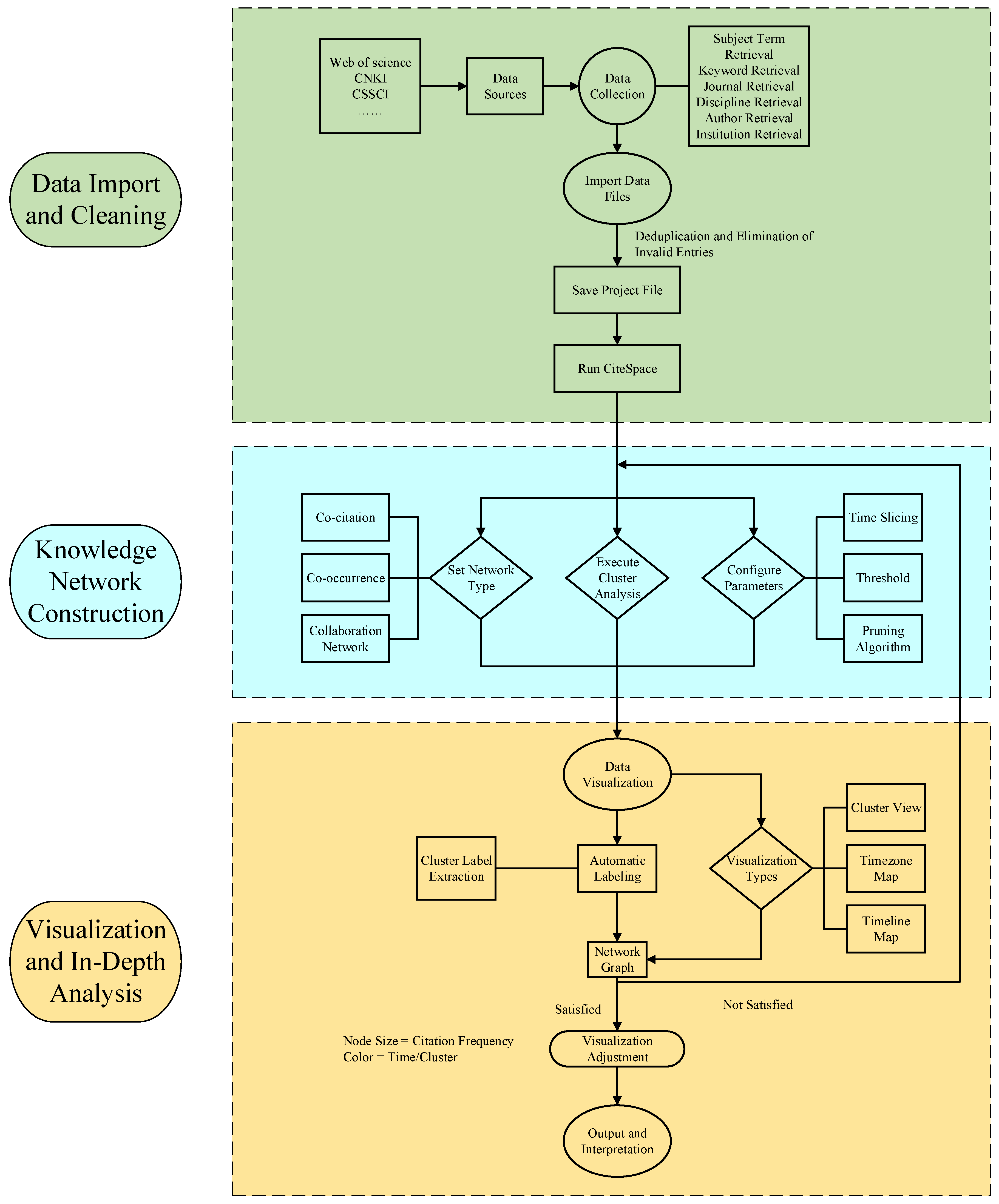
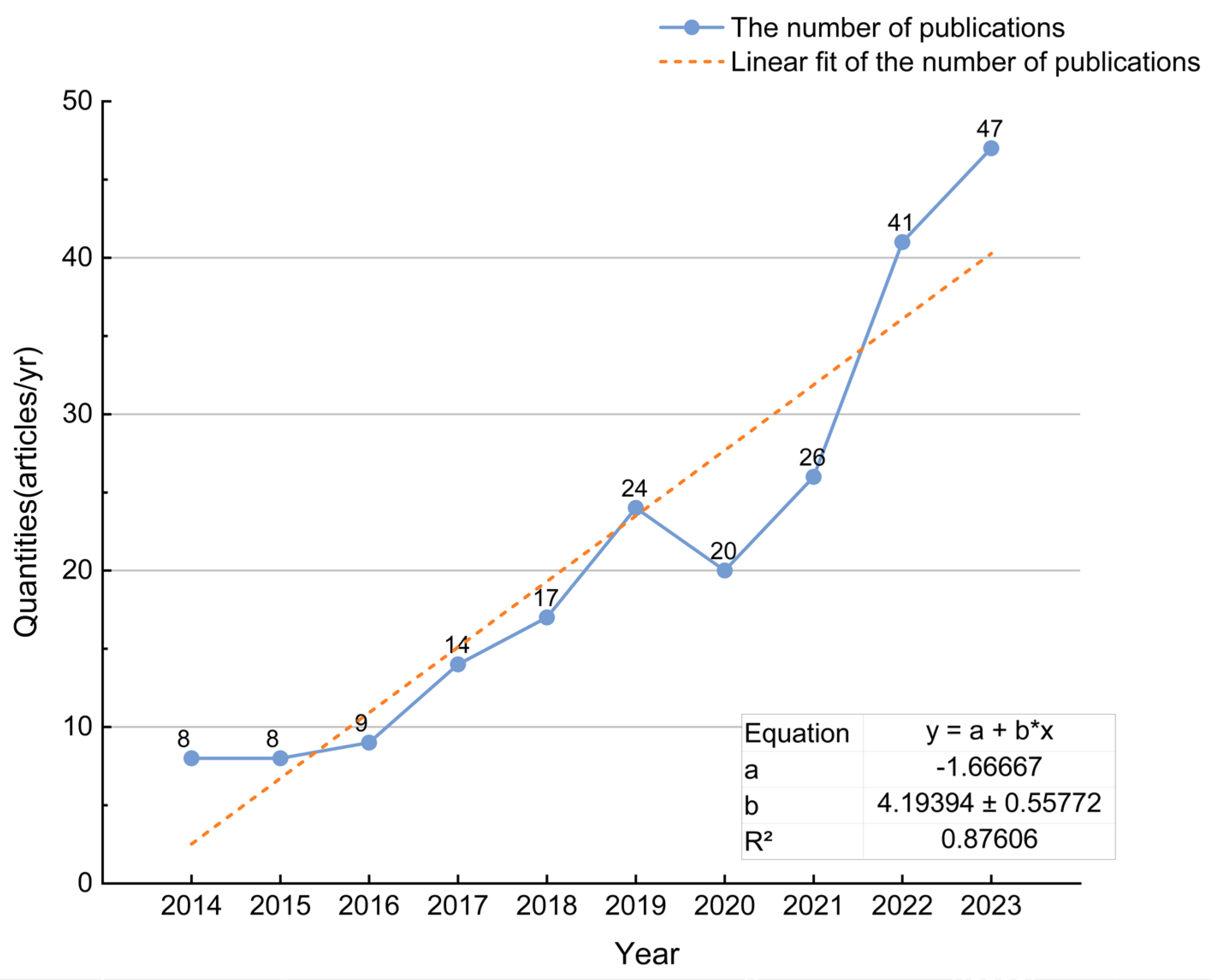
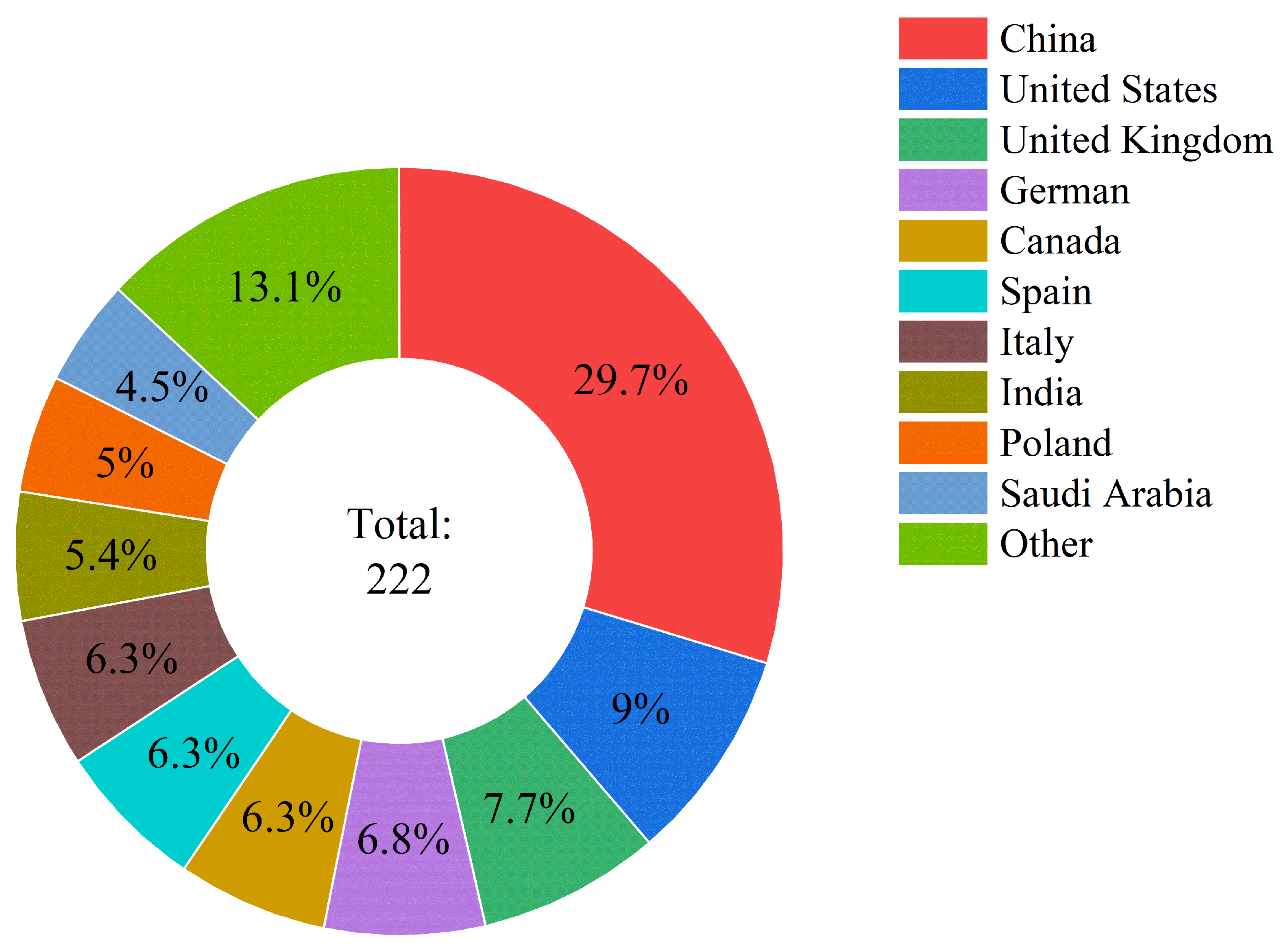
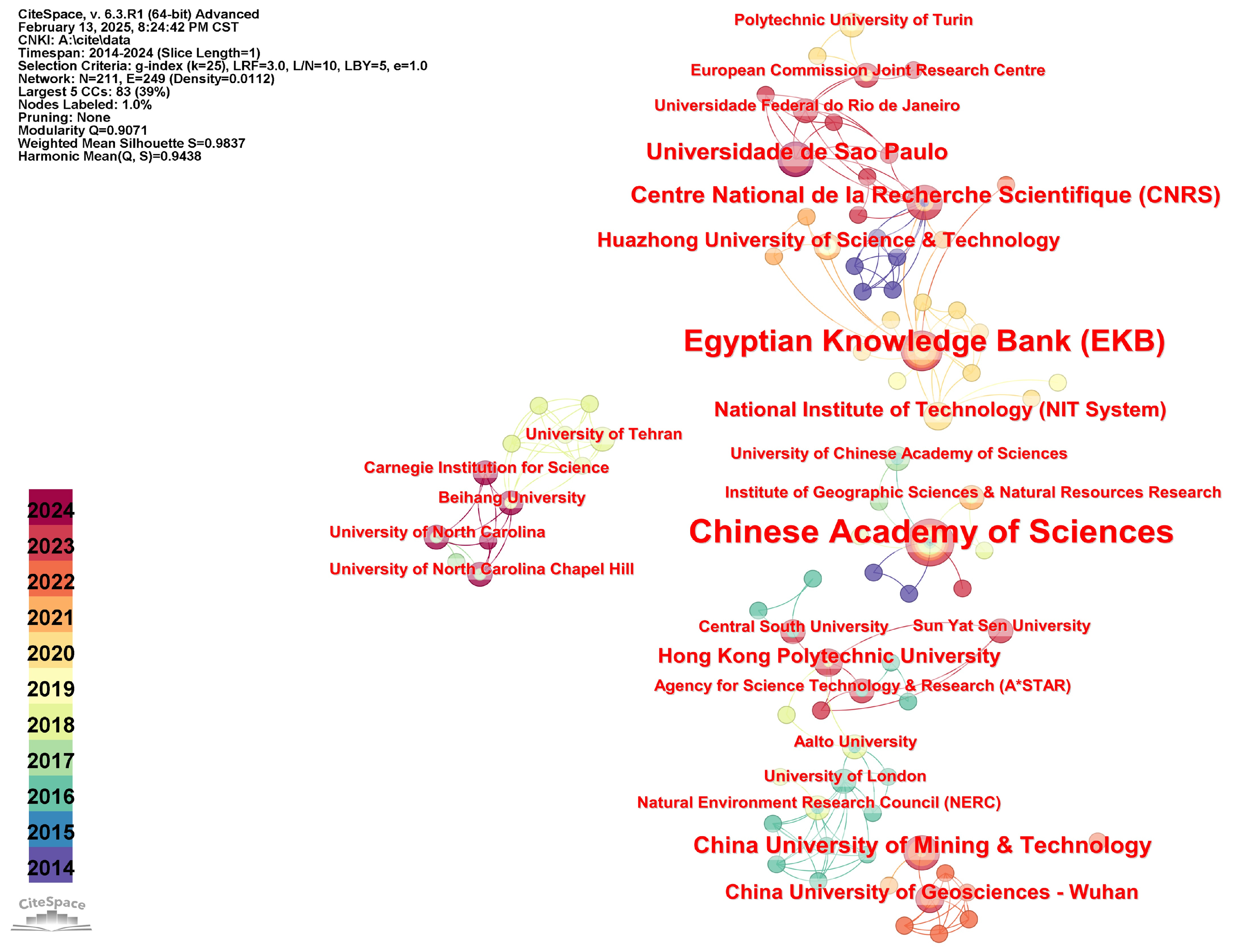
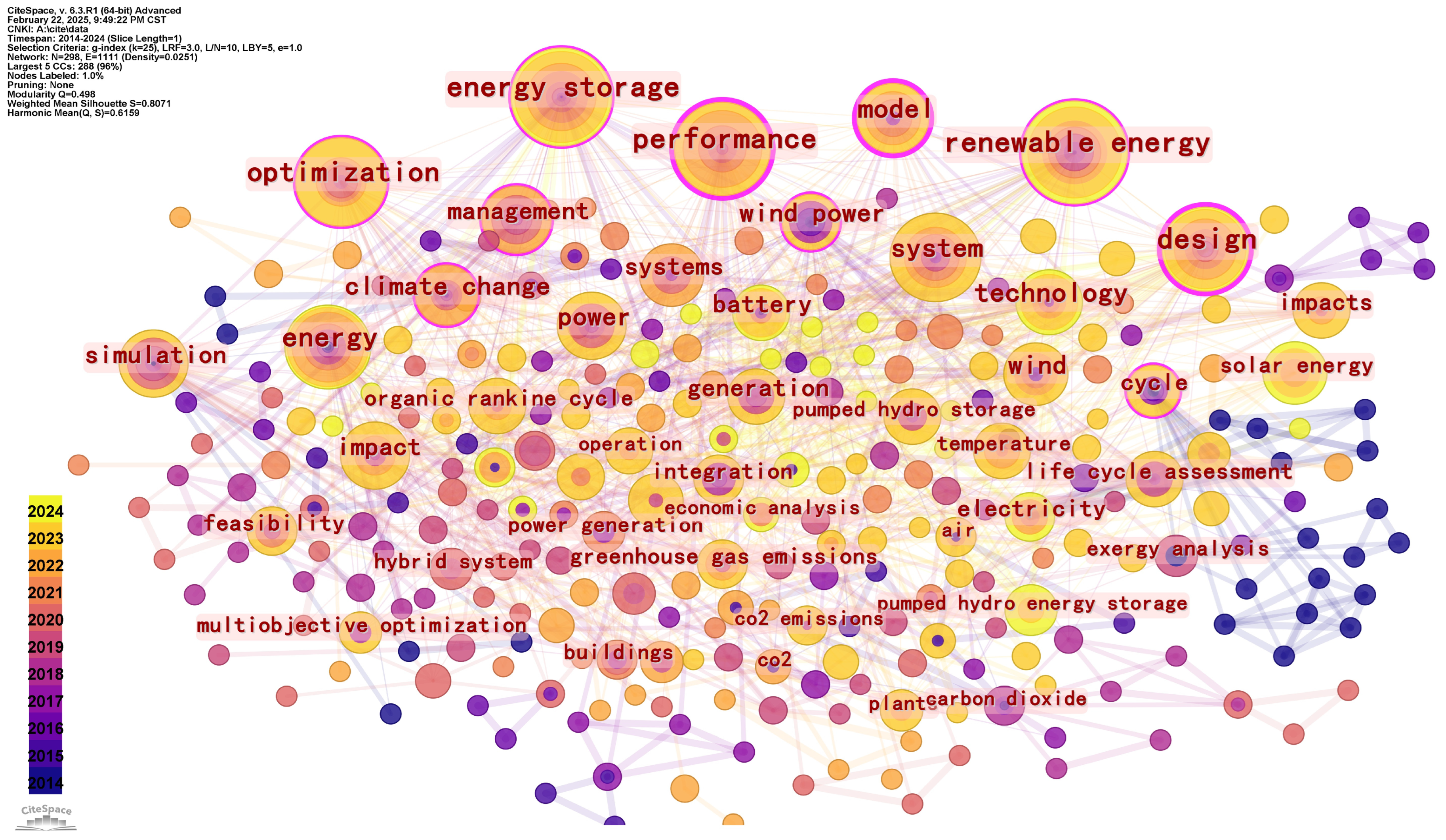
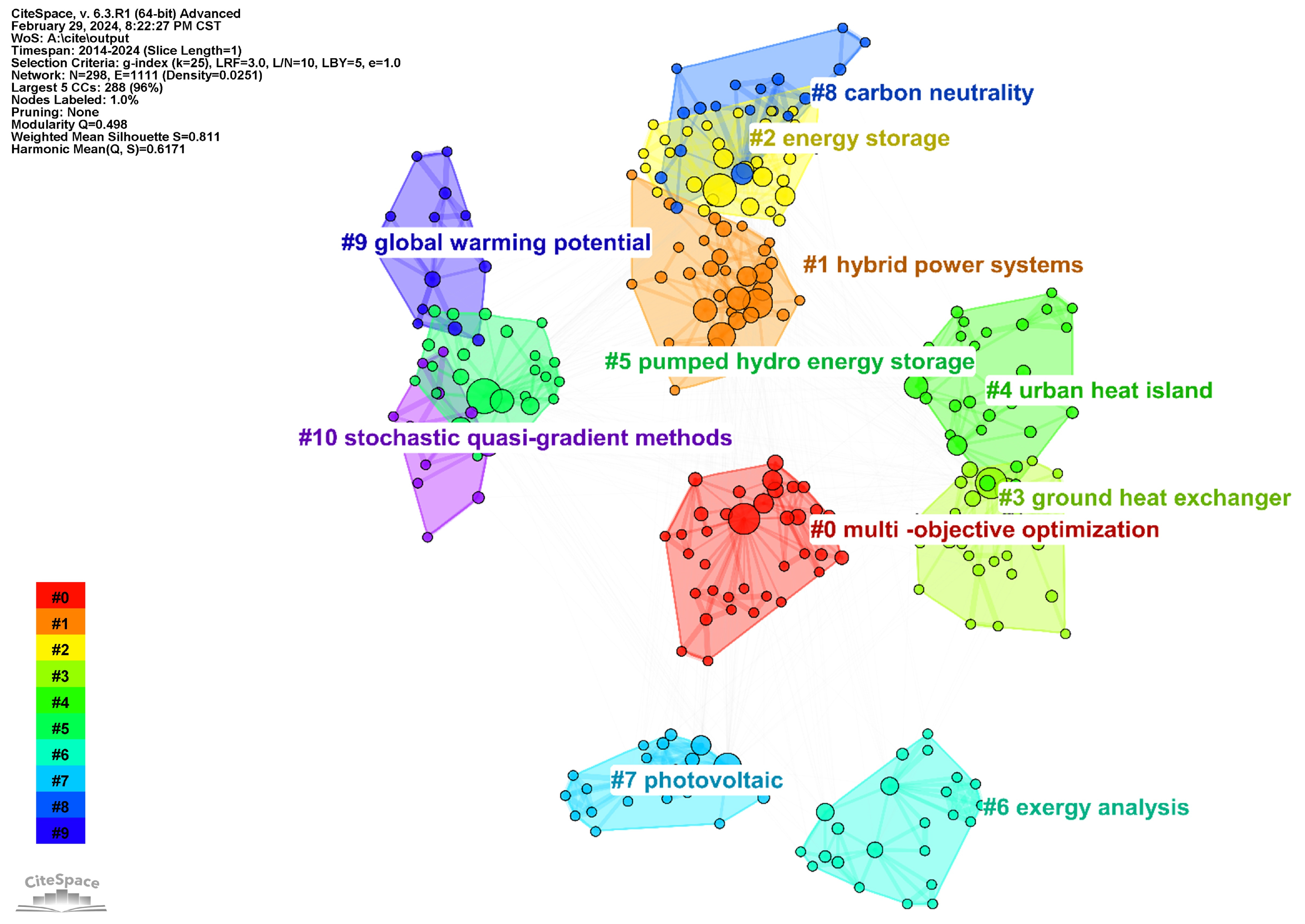

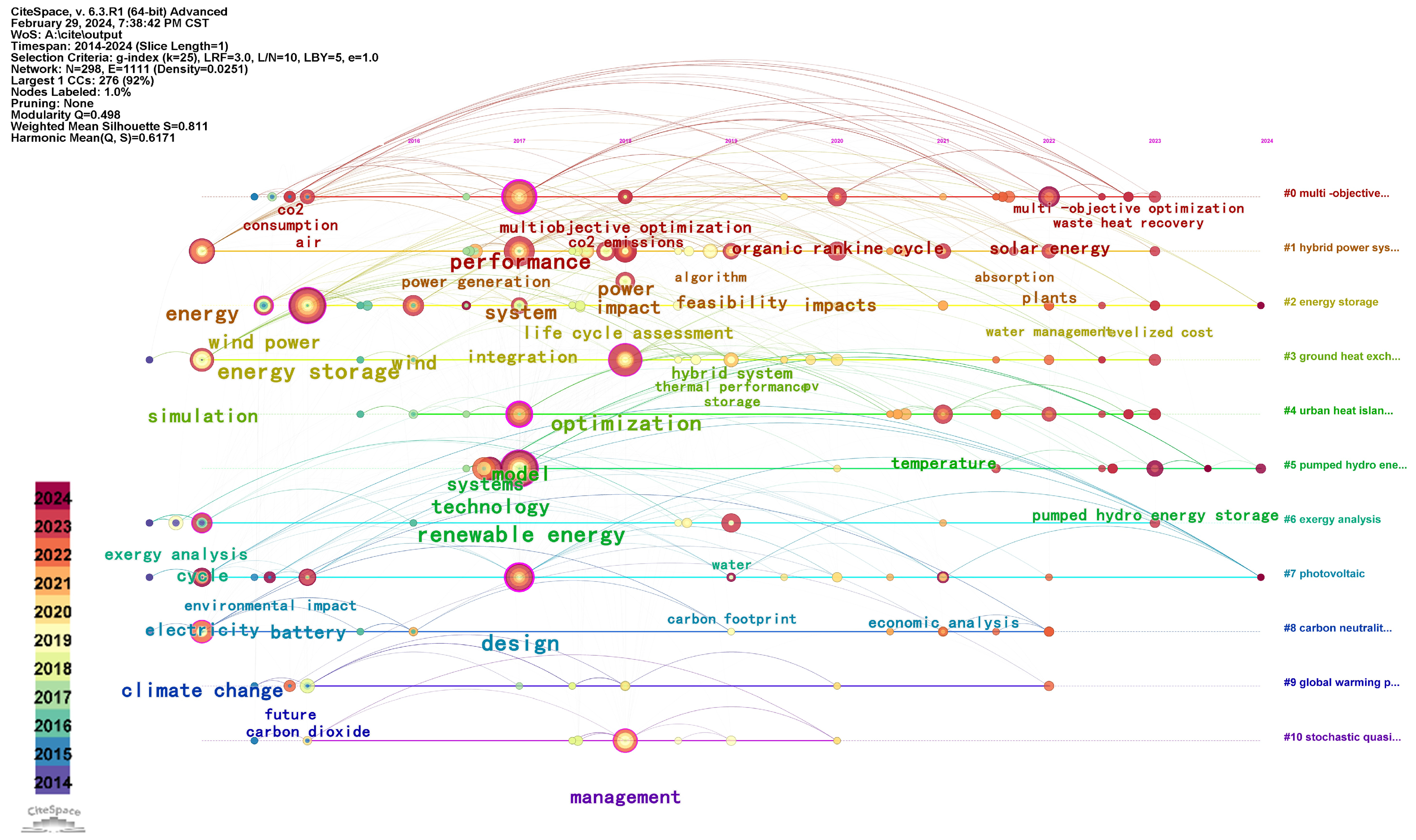
| Tools | Description | Key Features | Advantages | Limitations |
|---|---|---|---|---|
| CiteSpace 6.1R | A bibliometric software for visualizing scientific knowledge structures, patterns, and distributions. | (1) Multi-format data import; (2) Advanced visualization; (3) Cluster analysis and burst detection | (1) Unique dynamic hotspot tracking; (2) Identifies critical academic nodes; (3) Ideal for long-term network evolution | (1) Limited scalability for large datasets; (2) Steep learning curve for advanced features |
| VOSviewer-1.6 | Open-source software (Leiden University) for constructing and visualizing bibliometric networks. | (1) Multi-format compatibility (2) Network analysis; (3) Visualization tools | (1) Handles large datasets efficiently; (2) User-friendly interface | (1) Basic visualization options; (2) Requires data preprocessing skills |
| Gephi-0.9.2 | Open-source network analysis and visualization platform for large-scale graph data. | (1) Advanced network algorithms; (2) Customizable visualization; (3) Plugin support | (1) Deep analysis of complex networks; (2) Active developer community | (1) Challenging for beginners; (2) Resource-intensive for large datasets |
| HistCite Pro V2.1 | Citation analysis tool for mapping research trajectories and identifying seminal works. | (1) Citation-focused analysis; (2) Citation relationship mapping | (1) Rapid identification of influential literature; (2) Clear field evolution mapping | (1) Exclusive compatibility with Web of Science (WoS) database; (2) Limited functional scope |
| NVivo 12 Plus | Qualitative analysis software for unstructured/semi-structured data. | (1) Multi-data type support; (2) Coding/query tools; (3) Qualitative analysis | (1) Robust qualitative data handling; (2) Advanced data organization | (1) High licensing cost; (2) Moderate learning curve |
| Atlas.ti 8.4 | Qualitative data analysis platform for text, images, audio, and video. | (1) Multimodal data analysis; (2) Flexible coding/visualization; (3) Theory building | (1) Comprehensive qualitative tools; (2) Supports collaborative research | (1) Complex interface; (2) Requires significant training |
| Country/Region | Key Policies | Research Foci (2014–2024) | Data Sources |
|---|---|---|---|
| China | Medium- and Long-Term PHS Development Plan | Variable-speed units, mine-retrofitted PHS, ecological compensation|Nationa | National Energy Administration [106] |
| USA | Infrastructure Investment and Jobs Act (2021) | Underground PHS, hybrid storage systems, financing models | U.S. DOE [107] |
| EU | Renewable Energy Directive (2023 Revision) | Policy simulation, cross-grid synergy, carbon trading | IRENA [3] |
| Ordinal | Node Name | Number |
|---|---|---|
| 1 | Chinese Academy of Sciences | 9 |
| 2 | Egyptian Knowledge Bank (EKB) | 7 |
| 3 | Centre National de la Recherche Scientifique (CNRS) | 4 |
| 4 | AGH University of Krakow | 4 |
| 5 | Universidade de Sao Paulo | 4 |
| 6 | Norwegian University of Science & Technology (NTNU) | 4 |
| 7 | Indian Institute of Technology System (IIT System) | 4 |
| 8 | North China Electric Power University | 4 |
| 9 | China University of Mining & Technology | 4 |
| 10 | Southeast University—China | 4 |
| Ordinal | Frequency | Keyword | Ordinal | Centrality | Keyword |
|---|---|---|---|---|---|
| 1 | 28 | renewable energy | 1 | 0.27 | performance |
| 2 | 27 | energy storage | 2 | 0.23 | design |
| 3 | 23 | performance | 3 | 0.21 | model |
| 4 | 22 | optimization | 4 | 0.20 | energy storage |
| 5 | 19 | system | 5 | 0.19 | renewable energy |
| 6 | 18 | design | 6 | 0.17 | climate change |
| 7 | 18 | energy | 7 | 0.15 | optimization |
| 8 | 13 | model | 8 | 0.11 | cycle |
| 9 | 13 | technology | 9 | 0.10 | system |
| 10 | 13 | simulation | 10 | 0.10 | wind power |
| Cluster Type | Cluster Naming | Current Limitations | Integration Pathways |
|---|---|---|---|
| Core Research Clusters | multi-objective optimization (Cluster ID 0) | Objective functions have a narrow scope. Ecological–environmental variables are predominantly set as boundary constraints rather than core optimization objectives in existing models, leading to suboptimal solutions in the ecological dimension. | The computational core requires expansion. This involves integrating environmental assessment metrics (Clusters ID 8, Clusters ID 9) and key parameters from effect-based studies (Clusters ID 3, Clusters ID 4, Clusters ID 6) into the multi-objective optimization framework. |
| hybrid power systems (Cluster ID 1) energy storage (Cluster ID 2) carbon neutrality (Cluster ID 8) | Collaboration remains narrow. The co-occurrence between Cluster ID 8 and Clusters ID 1 and ID 2 primarily reflects preliminary integration with low-carbon energy technologies. It fails to incorporate broader ecological assessment dimensions. | ||
| Method Support Cluster | pumped hydro energy storage (Cluster ID 5) global warming potential (Cluster ID 9) stochastic quasi-gradient methods (Cluster ID 10) | Methodology-applications gap. Cluster ID 9 primarily co-occurs with Clusters ID 5 and ID 10, indicating its current function is limited to ex-post impact evaluation or serving conventional economic dispatch models. It fails to form an effective feedback loop with top-level strategic goals (Cluster ID 8), resulting in limited guidance for system design. | Develop quantitative ecological constraints. This cluster should advance multi-dimensional environmental impact assessment models beyond global warming potential. The quantified results must be dynamically integrated into the optimization models of Cluster ID 0, establishing an iterative “assessment-optimization-reassessment” framework for design and management. |
| Low Connectivity Clusters | ground heat exchanger (Cluster ID 3) urban heat island (Cluster ID 4) | Lacks integration with mainstream research. This cluster shows no significant co-occurrence with mainstream PHS technology development and evaluation systems. | Functional coupling with core systems. Future work should explore integrating geothermal exchange and urban heat island effects into the comprehensive performance evaluation system of power stations. |
| exergy analysis (Cluster ID 6) | Insufficient integration with engineering practice. This theoretical analysis method remains relatively isolated and has not been effectively incorporated into the multi-objective optimization processes of Cluster #0 or the systems engineering design workflows of Cluster ID 1. | Advancing system efficiency analysis. Exergy efficiency can be introduced as a higher-level objective function into the optimization models of Cluster ID 0. By integrating with Clusters ID 1, ID 2, and ID 5, this approach enables precise identification and reduction in exergy destruction within the system. | |
| photovoltaic (Cluster ID 7) | Narrow system boundaries. Current studies predominantly treat photovoltaics merely as a power supply unit, without coordinated optimization of its life-cycle environmental footprint with the ecological impacts of PHS. | Establish a PV-storage-environment coordinated planning framework. |
Disclaimer/Publisher’s Note: The statements, opinions and data contained in all publications are solely those of the individual author(s) and contributor(s) and not of MDPI and/or the editor(s). MDPI and/or the editor(s) disclaim responsibility for any injury to people or property resulting from any ideas, methods, instructions or products referred to in the content. |
© 2025 by the authors. Licensee MDPI, Basel, Switzerland. This article is an open access article distributed under the terms and conditions of the Creative Commons Attribution (CC BY) license (https://creativecommons.org/licenses/by/4.0/).
Share and Cite
Yin, H.; Zhao, X.; Chen, M.; Fu, Z.; Fang, Y.; Wang, H.; Li, M.; Luo, J.; Tan, P.; Fu, X. A Review on Ecological and Environmental Impacts of Pumped Hydro Storage Based on CiteSpace Analysis. Water 2025, 17, 2752. https://doi.org/10.3390/w17182752
Yin H, Zhao X, Chen M, Fu Z, Fang Y, Wang H, Li M, Luo J, Tan P, Fu X. A Review on Ecological and Environmental Impacts of Pumped Hydro Storage Based on CiteSpace Analysis. Water. 2025; 17(18):2752. https://doi.org/10.3390/w17182752
Chicago/Turabian StyleYin, Hailong, Xuhong Zhao, Meixuan Chen, Zeding Fu, Yingchun Fang, Hui Wang, Meifang Li, Jiahao Luo, Peiyang Tan, and Xiaohua Fu. 2025. "A Review on Ecological and Environmental Impacts of Pumped Hydro Storage Based on CiteSpace Analysis" Water 17, no. 18: 2752. https://doi.org/10.3390/w17182752
APA StyleYin, H., Zhao, X., Chen, M., Fu, Z., Fang, Y., Wang, H., Li, M., Luo, J., Tan, P., & Fu, X. (2025). A Review on Ecological and Environmental Impacts of Pumped Hydro Storage Based on CiteSpace Analysis. Water, 17(18), 2752. https://doi.org/10.3390/w17182752






